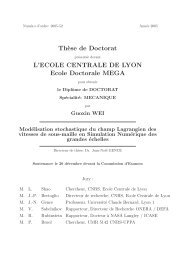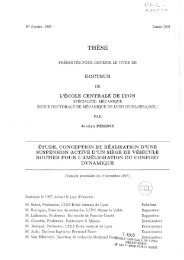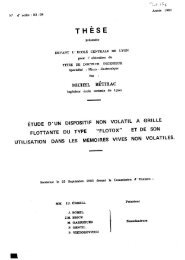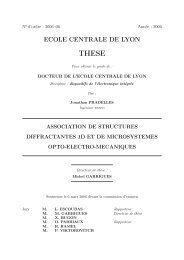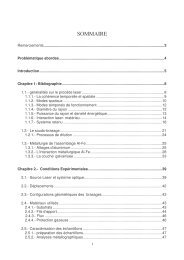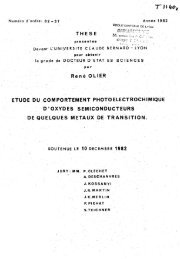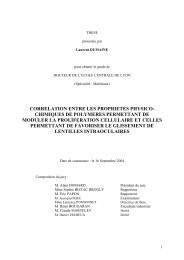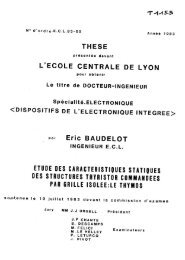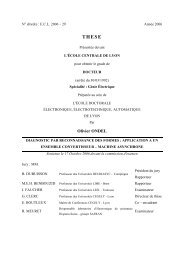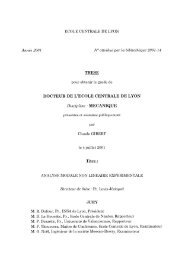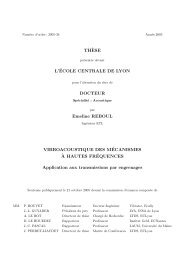Sur les mécanismes de rayures des vernis de finition automobiles
Sur les mécanismes de rayures des vernis de finition automobiles
Sur les mécanismes de rayures des vernis de finition automobiles
Create successful ePaper yourself
Turn your PDF publications into a flip-book with our unique Google optimized e-Paper software.
Les <strong>vernis</strong> <strong>de</strong> <strong>finition</strong> constituent la couche la plus externe <strong>de</strong>s revêtements peinture<br />
recouvrant <strong>les</strong> carrosseries automobi<strong>les</strong>. Ces <strong>vernis</strong> sont <strong>de</strong>s polymères thermodurcissab<strong>les</strong><br />
déposés sous forme <strong>de</strong> films minces <strong>de</strong> 40 à 50 tim d'épaisseur. Leurs fonctions sont <strong>de</strong><br />
protéger <strong>les</strong> couches inférieures du revêtement peinture <strong>de</strong>s dégradations du milieu ambiant<br />
et <strong>de</strong> donner au véhicule un aspect brillant et esthétique.<br />
Le lavage <strong>de</strong>s voitures aux machines automatiques munies <strong>de</strong> brosses provoque <strong>de</strong>s<br />
micro<strong>rayures</strong> à la surface <strong>de</strong>s <strong>vernis</strong>. Ces micro<strong>rayures</strong> sont <strong>de</strong> <strong>de</strong>ux types: ducti<strong>les</strong> (sans<br />
déchirures) et fragi<strong>les</strong> (avec déchirures). L'objectif <strong>de</strong> cette étu<strong>de</strong> est <strong>de</strong> relier <strong>les</strong><br />
<strong>mécanismes</strong> <strong>de</strong> <strong>rayures</strong> aux propriétés physiques et mécaniques <strong>de</strong>s <strong>vernis</strong>. Le rapport<br />
profon<strong>de</strong>ur <strong>de</strong> rayure sur épaisseur du <strong>vernis</strong> étant inférieur à 1/10, le <strong>vernis</strong> est considéré<br />
comme un matériau massif semi infini.<br />
Dans un premier temps, <strong>de</strong>s essais <strong>de</strong> nano-in<strong>de</strong>ntation et <strong>de</strong> nano-rayure combinés<br />
à <strong>de</strong>s observations au microscope à force atomique indiquent que la formation <strong>de</strong>s <strong>rayures</strong><br />
ducti<strong>les</strong> met en jeu <strong>de</strong>s mouvements locaux <strong>de</strong> chaînes polymères (énergies <strong>de</strong> transitions<br />
f3) et que leur cicatrisation met en jeu <strong>de</strong>s mouvements coopératifs <strong>de</strong> chaînes <strong>de</strong> polymères<br />
(énergies <strong>de</strong> relaxation a).<br />
Dans un <strong>de</strong>uxième temps, une étu<strong>de</strong> analytique du contact entre l'in<strong>de</strong>nteur et le<br />
<strong>vernis</strong> indique que la transition ductile/fragile est gouvernée à la fois par un critère en énergie<br />
<strong>de</strong> rupture et par un critère <strong>de</strong> dimension, tous <strong>de</strong>ux exprimés en fonction <strong>de</strong>s propriétés<br />
viscoélastoplastiques <strong>de</strong>s <strong>vernis</strong>, <strong>de</strong> la géométrie <strong>de</strong> l'in<strong>de</strong>nteur et <strong>de</strong> l'environnement.<br />
Cette étu<strong>de</strong> a permis d'i<strong>de</strong>ntifier <strong>les</strong> propriétés physiques et mécaniques <strong>de</strong>s <strong>vernis</strong><br />
qu'il faut optimiser pour améliorer la résistance à la rayure <strong>de</strong>s <strong>vernis</strong> et va donc plus loin<br />
que la notion <strong>de</strong> charge critique communément utilisée dans la littérature mais reliée à<br />
aucune propriété intrinsèque du matériau.<br />
Mots clés : nano-in<strong>de</strong>ntation, nano-rayure, polymères thermodurcissab<strong>les</strong>, ductile, fragile,<br />
relaxation a, relaxation f3, cicatrisation.<br />
Automotive clearcoats compose the most external layer of automotive coatings and<br />
consist of thermoset resins. Their thickness ranges from 40 to 50 tim. They ma<strong>de</strong><br />
automobi<strong>les</strong> glossy and protect them from environmental damage.<br />
Car wash brushes bring about microscratches at the surface of automotive<br />
clearcoats. There are both ductile and brittle scratches. Ductile scratches present no tearing<br />
and heating can make them disappear. On the contrary, brittle scratches show irreversible<br />
rips. The goal of this study is to relate scratches mechanisms to physical and mechanical<br />
properties of clearcoats. As the ratio scratch <strong>de</strong>pth over clearcoat thickness is smaller than<br />
1/10, the clearcoat is consi<strong>de</strong>red as a semi-infinite bulk material.<br />
On the one hand, nano-in<strong>de</strong>ntation and nano-scratch tests ad<strong>de</strong>d to AFM<br />
experiments show that the formation of ductile scratches involve local motions of polymer<br />
chains (f3 relaxation energies) whereas their healing involves large motion of polymer chains<br />
(a relaxation energies).<br />
On the other hand, an analytical study of the contact between the in<strong>de</strong>nter and the<br />
clearcoat show that the ductile/brittle transition is ruled by a fracture energy criterion and by a<br />
size criterion. Both are related to the viscoelastoplastic properties of the clearcoats, the<br />
in<strong>de</strong>nter geometry and the environment.<br />
The study has allowed to i<strong>de</strong>ntify the physical and me<br />
clearcoats which are to be optimised in or<strong>de</strong>r to improve their s<br />
further than the i<strong>de</strong>a of critical load commonly used in literature<br />
properties of the material.<br />
Keywords : nano-scratch, nano-in<strong>de</strong>ntation, thermoset resins,<br />
relaxation, healing.



